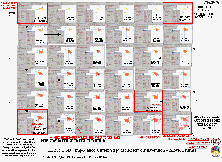|
 DvC2-12 DvC2-12
Figure DvC2-12 shows all 36 frames of the EI-27 CIB CARST sand "VOXEL-evolution" movie. It starts in the upper-right corner with its lowest D3D-impedance detection threshold ("cutoff"), forming its smallest, most compact sweet-spot around the exploratory drill site. Then it grows cutoff-incrementally to a maximum CIO size, shown in the lower-right corner where the cutoff value is -58. At this D3D-impedance cutoff value, the low-D3D-impedance of the EI-27 reservoir has found a path through the 3D matrix of VOXELs to join up with the EI-46 reservoir, possibly through a common, not-so-low-impedance aquifer. The volume (acre-feet) and area (acres) of each CIO in the VOXEL-evolution process, is annotated on each frame. VoxelGeo calculates these from the user-specified:
Seismic trace-spacing (feet),
TWT sample interval (ms), and
Approximate vertical speed-of-sound (f/s), through the (gas reservoir sand) CIO.
Significantly, the lower-left frame shows a map-view of the CIO (Impedance cutoff = -68), with its interpreted "Possibly All Gas" size and shape. Two independent factors lead to this "Gas" identification ... which is really what D3DSP interpretation is all about: recognizing the largest D3D-CIO that can be interpreted to represent a valuable, buried, three-dimensional common-impedance object (target). First, the next frame to the right (cutoff = -66) shows that this slightly higher impedance cutoff value allows a number of scattered, down-dip (to the east), loosely connected pockets to become attached to this growing CIO, and the 3D-size and -shape of these "bubbles" is interpreted to look more like a wet-sand than a gas-sand object. This is because many of them lay below the otherwise flat base (see Figure DvC2-06, showing the possible gas-water contact at 2.7 seconds) of the previous, (cutoff = -68) CIO. Second, the ST-46 CIB CARST gas sand CIO (Norcen #2 discovery well) calculates to have a recoverable gas volume of 29.2 bcfg, IF the D3D-impedance = -68 cutoff is used. This Norcen well was still making 13 mmcfgpd as the spec-seismic was being D3D-reprocessed, and the D3DSP-analysis was being worked up. An astute engineer reported that it had just begun to make significant water (in 8/02), and that its estimated ultimate recovery was probably close to 29 bcfg. This lent confidence to using the cutoff = -68, as a local discriminator for a gas sand versus a water sand.
The evolving, 36-frame “animation” (movie) can be viewed under the "Multimedia Animations" button, on the VTV Home Page.
|

